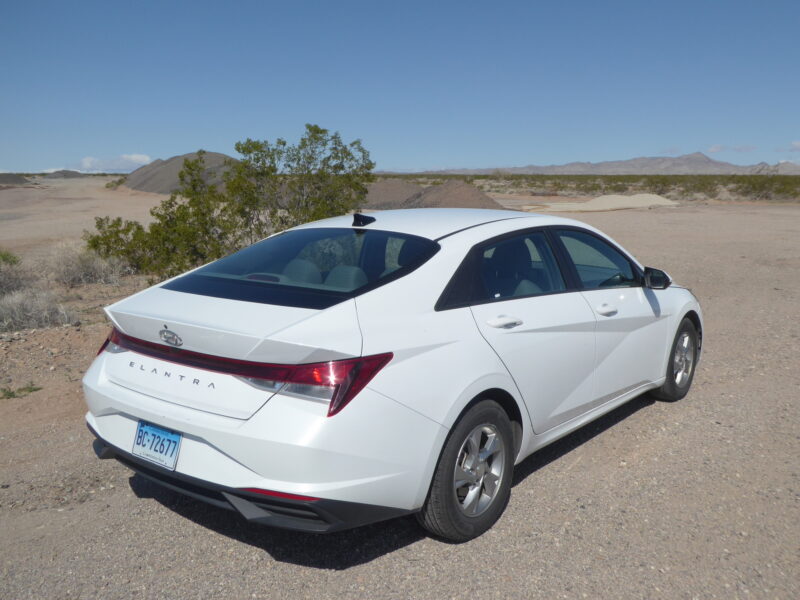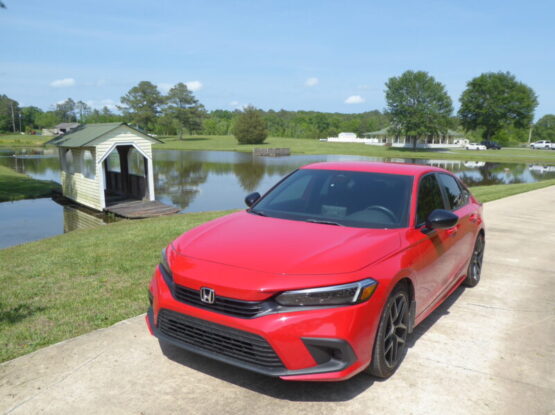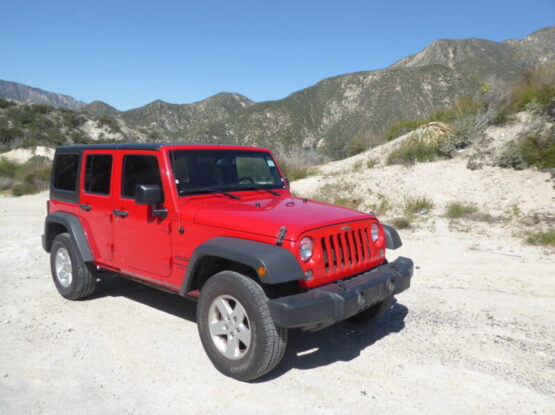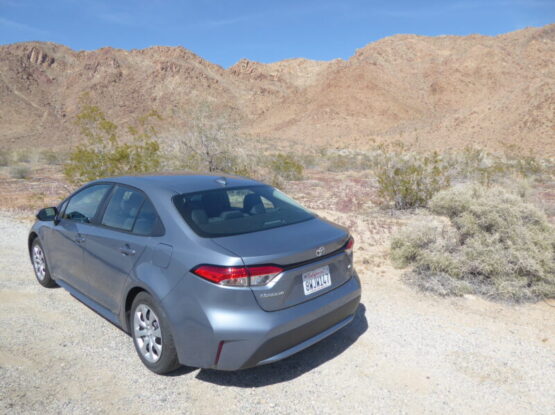The Hyundai Elantra goes back to 1990, when the Korean automotive giant produced a mid-sized family saloon which was good enough to be mentioned in the same breath as established European mainstream cars such as the VW Jetta, Rover 400, Vauxhall Cavalier and even the soon to emerge Ford Mondeo. Maybe not quite up to the same standards as those illustrious models in all respects, the significantly cheaper cost of the Elantra should have made everyone take due notice that the Koreans really were serious about becoming a dominant player in the world’s car markets. The first Elantra was sold in the UK, though missing the leading E on its name to avoid confusion with the Lotus Elan, and it sold moderately well, but it was North America which really started to embrace this Korean newcomer, and sales built up steadily. Every five or six years since then, Hyundai have offered a completely new version of the Elantra. The latest, the seventh generation of the model was launched in West Hollywood in March 2020, with sales starting later in the year as a 2021 model year car. Visually, this was a major departure from the sixth generation car. It teased a new “parametric dynamics” design language, with a return to a longer and wider fastback rear end sports sedan style which certainly makes it stand out in the highly competitive mid-sized sedan class. The interior features more rear legroom and a new instrument panel design with available twin digital display screens and there has been an addition of all the latest safety and ADAS kit. Under the skin, not only does the car share much with the Hyundai i30 models sold in Europe, but it is a very close relative of the Kia Forte. Although it has been on sale in the US market for a couple of years, the rental fleets still don’t have large numbers of them, as they seemingly stocked up on the sixth generation car right at the end of its production life, and there are still lots of these available, but I did find a seventh generation car for my final rental from Hertz’ Las Vegas airport. As I had driven the closely related Kia Forte only a couple of days prior, I was interested to see how two visually quite different looking but mechanically similar cars would compare and indeed how in absolute terms the Elantra would stack up in what is still a sizeable and closely contested class.
The lesser versions of the Elantra all get the 2.0 litre four cylinder engine that sees service in a number of other mid-sized Hyundai and Kia models such as the Kona and Kia’s Forte. It generates 147 bhp and it comes coupled to a continuously variable automatic transmission. It is smooth and generally quiet and the Elantra has sufficient acceleration to keep up with the flows of traffic, though you will need to work it quite hard. Freeway cruising, something that I did quite a lot of on my trip to Lake Hvasu City, on long, flat roads, is peaceful, which was something of a relief. There are three Drive Modes: Normal, Sport and Smart. I left it in Normal. In total I covered 333 miles in one day, and the car took 8.1 gallons to fill it. That works out at 41.11 mpg US or 49.11 mpg Imperial. I think the Elantra actually did rather better than that as on the outbound journey the trip computer reported 50 mpg and for the day as a whole it said 46.1 mpg. I did note that the gauge moved off Full very quickly, suggesting to me that the car probably was not exactly full when I collected it.
Just like the Kia Forte, the Elantra was pleasant enough to drive, but ultimately pretty unremarkable. The steering is light and has little in the way of feel especially around the straight ahead position. All Elantra models have front wheel drive, so not surprisingly, the handling is safe and predicable and there are good levels of grip and little in the way of body roll from what I could tell, though my journey seemed largely to consist of roads that ran straight for literally dozens and dozens of very flat miles across southern Nevada. The ride was smooth and comfortable on what were clearly quite well surfaced roads. Visibility can be a problem. There are very small door mirrors and the rear screen is very angled so you really do need to rely on the rear-view camera when parking up. There is a whole slew of the latest ADAS features, of course. Thankfully, Lane Keep Assist proved easy to turn off, and you will want to do just that.
The interior of the Elantra seemed rather more plasticky than many of the Hyundai’s rivals. There is a lot of grey here and plenty of hard surfaces. In an attempt to provide some visual interest and the impression of a driver’s cockpit, the central console area, which is large, has a swooping arch style grab handle that sorts of separates the driver’s side from the passenger’s. The instrument cluster contains three circular dials which overlap a little. There is a large central speedometer which includes the fuel level. To the left is the rev counter which also includes the water temperature whereas the circle to the right is used for the trip computer displays. These are selected from buttons in the steering wheel hub where you also find audio repeaters and cruise control settings. There are two column stalks which also include the lights, which have an auto function. The centre of the dash contains an 8” colour touch screen for the infotainment system. In SE trim this is somewhat basic, lacking both navigation and XM Satellite radio but you do get Bluetooth, wireless Apple Car Play and Android Auto. The audio system has just four speakers, but sound quality seemed perfectly acceptable. There are some proper buttons to either side of the unit. Beneath this are three rotary dials for the air conditioning system. Overall, the controls are simple and easy to use, which has to be welcome in these days of ever more complex set-ups.
SE trim means cloth seats and they are, unsurprisingly, manually adjustable. The passenger does not get height adjustment, but at least you can adjust the height of the seat belts and the steering column does telescope in/out as well as up/down, so it was easy to get the driving position I wanted. Although there is not much in the way of side bolstering to hold you in when cornering, I found the seat to be comfortable and was able to complete a long and rather tedious journey without feeling the need to sit on anything better.
The rear seat area is quite spacious, with ample legroom – two inches more than was offered in the previous generation Elantra – even when the front seats are set well back. There is just enough headroom, despite the sloping rear roof line. Sadly, occupants here do really badly for places to store odds and ends, as there are no seat back pockets and the door bins are tiny. In SE trim, you have to live without a rear armrest, too.
The boot is a decent size but the fastback styling means that the boot lid itself is quite small, so you might struggle to get items through the opening even though there is plenty of space for them once through the slot. The asymmetrically split rear seat backrests do drop down, to give a much longer load platform, so I guess in some cases you could also thread things in this way. There is a space saver under the floor with space to tuck a few items around it. Inside the cabin, provisions for odds and ends is better for front seat passenger than those in the back, with a reasonable sized glovebox, door pockets, a recess in front of the gearlever and a central armrest cubby, the placement areas you get in almost all cars these days.
Form launch, the 2021 Hyundai Elantra was offered to US buyers in four trims: SE, SEL, Limited and N Line. The lower three trims come with a 147 bhp 2.0-litre four-cylinder engine and a continuously variable automatic transmission (CVT). The sporty N Line comes with a 201 bhp turbocharged 1.6-litre four-cylinder and either a six-speed manual or seven-speed dual-clutch automatic transmission. There is also a Hybrid model available and from July 2021 there was a truly sporty Elantra N which has a 2.0 litre turb engine putting out 276 bhp and is the US market alternative to the highly rated i30N that has impressed many a European. The base SE trim is a good pick for most shoppers. It has plenty of standard infotainment features, as well as driver aids such as pedestrian detection and forward automatic emergency braking. The entry-level Elantra SE comes standard with an 8-inch touch screen, a four-speaker stereo, wireless Apple CarPlay and Android Auto, HD Radio, two USB ports, Bluetooth, cloth upholstery and remote keyless entry. Active safety features include a rearview camera, forward collision warning, forward automatic emergency braking, pedestrian detection, blind-spot monitoring, rear cross-traffic alert, lane-keep assist, lane-follow assist, driver-attention monitoring, high-beam assist and safe exit warning. Stepping up to the Elantra SEL adds two additional speakers, satellite radio and push-button start. When the vehicle was new, the SEL trim was available with a power-adjustable driver’s seat, heated front seats, a leather-wrapped steering wheel, heated side mirrors, a sunroof, an eight-speaker Bose premium audio system, wireless device charging, cyclist detection and adaptive cruise control. The Elantra Limited gains cyclist detection, adaptive cruise control, rear parking sensors, park distance warning, reverse collision avoidance assist and highway driving assist. It also gains a 10.25-inch touch screen, voice recognition, navigation, an eight-speaker Bose premium audio system, wireless device charging, ambient interior lighting, a leather-wrapped steering wheel and leather upholstery. Notably, you’ll need a wired connection to use Android Auto and Apple CarPlay in this trim. In addition to the upgraded powertrain, the Elantra N Line comes with most of the SE trim’s features as well as N Line interior and exterior styling, a sporty suspension system, a six-speaker stereo and combination leather and cloth sport seats.
The Elantra struck me as honest straight-forward family saloon which would meet the needs of many just fine, though it is unlikely to excite any of those prospective owners or drivers. SE trim is perhaps a bit lacking in a few nice convenience features, so an SEL would probably be worth the extra outlay, but look beyond that and you have a car that goes well enough, would seem to be quite frugal, is pleasant to drive if not exactly fun and with enough space for four people and their luggage. That’s all that a lot of people are looking for, so decrying the lack of sense of fun is perhaps not entirely appropriate, even if it is something I would look for even in family transport, and of course Hyundai do offer the N Line version or even the full-on N for the enthusiasts. Under the skin, the Kia Forte and the Hyundai Elantra are very similar, so choosing between them would come down to whether you prefer the rather more adventurous styling of the Hyundai or prefer the more traditional look of the Kia. If you want bold styling, then the Honda Civic – albeit toned down more than somewhat in its latest iteration – could be worth a look, and you should not underestimate the Toyota Corolla which still sells in larger quantities than any of its rivals. I’ve yet to drive the latest car but understand it is significantly better than its predecessor. And of course, for a more engaging drive, there is the Mazda 3 which would almost certainly be my pick of this class. You rarely find those in the rental fleets, though, where you are much more likely to come across a row of Kia Forte, Hyundai Elantra and the Nissan Sentra. Standards are such now that you should probably toss the proverbial coin to decide which one to pick, as there really is not much to distinguish them. Great for the person who wants simple transport. If not quite such good news for the enthusiast, though at least the cars have no real weak points any more and hurrah for that.
































































